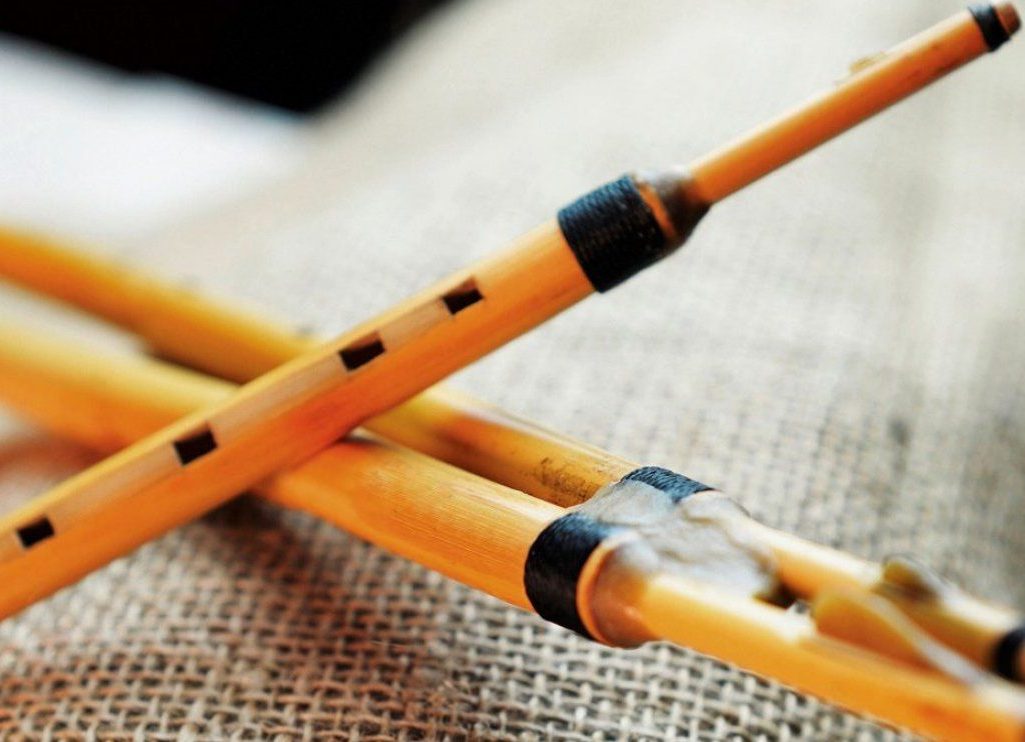Launeddas
Woodwinds
Europe
Between 1001 and 1900 AD
Video
The launeddas is a traditional woodwind instrument from Sardinia, Italy, known for its unique construction and musical capabilities.It consist of three pipes made from cane: one drone pipe called the tumbu, and two melody pipes known as mancosa and mancosedda.
The tumbu produces a continuous deep sound, while the other two pipes have five finger holes each, allowing for melodic play. Each pipe features an idioglot single reed (known as cabitzina) that vibrates to produce sound. The player uses a technique called circular breathing, which enables them to maintain a continuous sound by inhaling through the nose while blowing air out through the mouth.
The player holds two pipes with one hand and the third pipe with the other, using their fingers to cover the holes and create different pitches. This requires precise finger control and breath management.
Historical Context
Origins: The exact origins of the launeddas are unclear, but evidence suggests that similar instruments have existed since ancient times. A bronze statuette from the Nuragic period (around the 8th to 9th century B.C.) depicts a musician playing a three-pipe instrument resembling the launeddas.
Cultural Significance: Historically, launeddas were used in both secular and religious contexts, accompanying dances and processions. They have been integral to Sardinian folk music and are often played during festivals and celebrations.
The first written references to launeddas date back to the 13th century, indicating their established presence in Sardinia’s musical culture. The most significant early evidence of launeddas in Sardinia comes from the Nuragic civilization, which thrived from approximately 1800 BC to 238 BC. A notable artifact is a bronze statuette known as bronzetti, dated to the 10th century BC, depicting a musician playing a three-pipe instrument resembling the launeddas. The launeddas originate from Sardinia, an island region of Italy. This traditional wind instrument is deeply rooted in Sardinian folk music and has been played for over 3,000 years, making it one of the oldest continuous musical traditions in Europe.
Development and Usage
The launeddas consists of three pipes: one drone pipe (the tumbu) and two melody pipes (the mancosa and mancosedda). The instrument is played using a technique called circular breathing, allowing musicians to maintain a continuous sound.
Historically, launeddas were used in both secular and religious contexts, accompanying dances and processions. They have played an essential role in Sardinian folk music, often performed during festivals and religious ceremonies.
The first written references to launeddas in Sardinia date back to the 13th century, indicating their established presence on the island. Various documents, including travel reports and notary deeds, attest to their use by professional musicians at that time.
Modern Context
Revival Efforts: In the late 20th century, the launeddas faced a decline as fewer musicians practiced the tradition. However, a revival began in the 1980s with the establishment of schools dedicated to teaching the instrument. Notable figures like master musician Luigi Lai have been instrumental in promoting launeddas on national and international stages
UNESCO Recognition: The importance of launeddas has been recognized by UNESCO, which invited Luigi Lai to perform at an event highlighting Mediterranean music and culture in Paris in 2014
Types of Launeddas
The launeddas is a traditional woodwind instrument from Sardinia, characterized by its unique construction and sound. Within the launeddas family, there are several different types, each identified by specific names and characteristics.
- Mediana: This is one of the most common types of launeddas, typically used for a variety of musical contexts. It is known for its balanced sound and versatility.
- Fiorassiu: A type that is recognized for its distinct tonal qualities, often used in traditional Sardinian music.
- Punt’é Organu: This variety is characterized by its specific tuning and is often used in religious and ceremonial music.
- Spinellu: Another variant that has unique sound characteristics, contributing to the diverse repertoire of launeddas music.
- Cuntzertus: A broader category that includes various tunings and sizes of launeddas, allowing players to perform in different keys. Each type within this category may have its own name based on its tuning (e.g., puntus).
- Other Variants: There are additional types that may not be as widely recognized but still play a role in the traditional music of Sardinia.
Characteristics
Each type of launeddas typically consists of three pipes: one drone pipe (tumbu) and two melody pipes (mancosa and mancosedda). The differences between the types often relate to their size, tuning, and tonal qualities.
The instrument is played using circular breathing, allowing musicians to create continuous sound without breaks, which is essential for performing longer pieces.
Cultural Significance
Launeddas are integral to Sardinian folk traditions, often accompanying dances and religious ceremonies. The different types allow for a rich variety of musical expressions within the cultural context of Sardinia.
FAQ
What materials are used to make the launeddas?
The launeddas are traditionally crafted from reeds or cane, chosen for their flexibility and resonant sound. The double-reed mouthpiece is meticulously shaped from cane or bamboo. The instrument's body is typically made from durable woods like juniper or cypress, which enhance its tonal richness and ensure longevity.
What are the unique characteristics of the launeddas?
The launeddas stand out for their triple-pipe design, which includes a drone pipe and two melody pipes, producing a rich, layered sound. Played with double reeds similar to those of an oboe, they create a vibrant, distinctive tone. Circular breathing, a specialized technique, allows musicians to sustain a continuous, uninterrupted sound.
What are the historical origins of the launeddas?
The launeddas have their origins in Sardinia, Italy, with evidence tracing back to the Middle Ages. They likely evolved from ancient Mediterranean reed instruments and were influenced by Greek and Roman musical traditions. Over centuries, they became an integral part of Sardinian cultural and ceremonial practices.
 Links
Links
References
Other Instrument
Categories


















